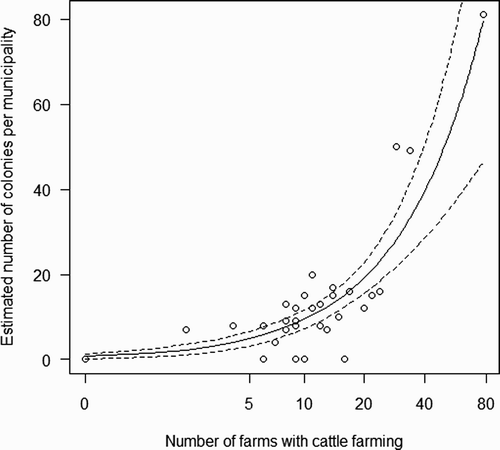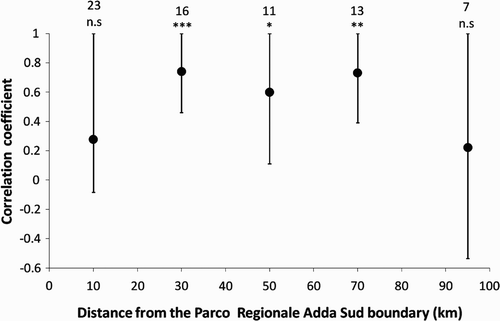Figures & data
Figure 1. The study area: (a) Lombardy (black) in Italy (grey) and Europe; (b) Lombardy with the 489 municipalities in the low Po plain (grey), the Parco Regionale Adda Sud (white border) and the 168 point counts (dots) used for map validation; (c) the Park with the 160 censused farms (open circles, farms with no breeding Barn Swallows; grey circles, 1–9 breeding pairs; full circles, 10–76 breeding pairs); (d) predicted colony presence and size at all the 682 farms in the municipalities of the Park based on both logistic and linear models (open circles, farms where the logistic model predicted absence of swallows and the quasi-Poisson model predicted presence of 2 breeding pairs[se =± 0.66, 95% CI = 1–4]; grey circles, farms with 7 predicted breeding pairs [se =± 3.16, 95% CI = 3–17]; full circles, farms with 14 predicted breeding pairs [se =± 1.41, 95% CI = 12–17]).
![Figure 1. The study area: (a) Lombardy (black) in Italy (grey) and Europe; (b) Lombardy with the 489 municipalities in the low Po plain (grey), the Parco Regionale Adda Sud (white border) and the 168 point counts (dots) used for map validation; (c) the Park with the 160 censused farms (open circles, farms with no breeding Barn Swallows; grey circles, 1–9 breeding pairs; full circles, 10–76 breeding pairs); (d) predicted colony presence and size at all the 682 farms in the municipalities of the Park based on both logistic and linear models (open circles, farms where the logistic model predicted absence of swallows and the quasi-Poisson model predicted presence of 2 breeding pairs[se =± 0.66, 95% CI = 1–4]; grey circles, farms with 7 predicted breeding pairs [se =± 3.16, 95% CI = 3–17]; full circles, farms with 14 predicted breeding pairs [se =± 1.41, 95% CI = 12–17]).](/cms/asset/d5b35fd5-e18e-4773-be89-14e7ecef974a/tbis_a_609883_o_f0001g.gif)
Table 1. Binomial, zero-truncated Poisson and Poisson glm (the latter fitted by quasi-likelihood estimation) of the presence, colony size and number of breeding pairs per farm of Barn Swallows.
Table 2. Poisson glm of the estimated number of Barn Swallow colonies per municipality in the Park.
Figure 2. Estimated number of Barn Swallow colonies in relation to the number of farms with cattle farming at each municipality of the Park. The fitted Poisson glm curve from (solid line) and its 95% CLs (dashed lines) are shown.

Figure 3. Predicted Barn Swallow distribution at regional scale: (a) predicted density of Barn Swallow colonies; (b) predicted number of Barn Swallow colonies in all the 489 municipalities of the low Po plain. The municipalities with the predicted maximum density (4.16 ± 0.42 se colonies km−2) and the predicted maximum number of colonies (208 ± 67 se) are indicated. Highlighted areas in (a) include 11.7% of colonies in 3.7% of the study area; highlighted area in (b) includes 10.2% of colonies in seven municipalities; small maps represent standard errors of estimates at each municipality.

Figure 4. Correlation coefficients between estimated density of colonies and mean number of Barn Swallow pairs per point count in municipalities at different distance belts (<20 km; 20–40 km; 40–60 km; 60–80 km; and >80 km) from the Park boundary. Bars represent one-sided 95% CLs; numbers represent sample sizes; n.s., P > 0.05; *P ≤ 0.05; **P < 0.01; ***P < 0.001 (one-tailed tests).
